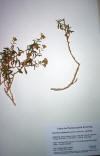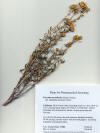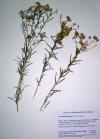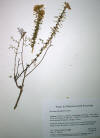|
Isocoma acradenia var.
acradenia |
Isocoma acradenia var.
bracteosa
|
|
Isocoma acradenia var.
bracteosa |
Isocoma acradenia
var. bracteosa
|
|
Isocoma pluriflora
|
Isocoma pluriflora
|
|
Isocoma tenuisecta
|
|
|
Trees and Shrubs of Kern County (Sep 2012) Key to varieties of Isocoma acradenia
1. Involucral bracts
with a short hair-like point beyond the blunt tip; 1. Involucral bracts without terminal hair-like awn......................................................... 2
...... 2. Leaves toothed along margins; rare in Kern Co.,
Tehachapi ...... 2. Leaves entire; rare in Kern Co., Mojave Desert........................... var. acradenia
Isocoma acradenia (Bigelovia acradenia Greene 1883) Greene 1894 [Haplopappus acradenius S. F. Blake 1925] var. acradenia. Goldenbush. Rounded leafy shrub, 0.3–1 m, woody near base, stem-bark white, leaves alternate, not reduced in size up the stem, mostly entire, abruptly narrowed to a pointed apex; flowering in the fall (Aug–Nov), fruiting heads may persistent to the spring with the bracts curved outwards (recurved) and with a thicker dark spot (green spot when in flower) on the upper part of each bract; flowers yellow, the narrow tube abruptly expanded into an inflated throat. Subalkaline flats and washes, 1,500–3,000 ft, Mojave Desert. Kern Co.: “Scarce in sandy soil or on stabilized dunes from southwest of Rosamond east to Rogers Dry Lake” (Twisselmann), 65–701 m (CCH). Isocoma acradenia var. bracteosa (Isocoma bracteosa Greene 1906) G. Nesom 1991 [Haplopappus acradenius ssp. bracteosus H. M. Hall 1928; H. acradenius var. bracteosus McMinn 1939] Pale-leaf goldenbush. Subshrub with many slender leafy erect stems to 1.5 m, gradually woody towards base, bark white in age; leaves alternate, often in fascicles, widest above the mid region, 2–3× longer than wide, 2–3 cm, shorter and narrower on flowering branches (6–15 mm), pale green, to grayish or whitish green, turning yellowish brown with age, entire to slightly toothed along margins near widest part of leaf, with minute glandular pits; flowering Aug–Nov; flower heads often 5 in number on short peduncles near apex of stems; involucral bracts imbricate in 3–4 ranks, swollen near tips and abruptly extending into a short hair-like point, spreading with age; flowers yellow, the narrow tube abruptly expanded into an inflated throat; cypselae with terminal unequal bristles, to 3.5 mm long, pericarpium short ellipsoid, hairy ~2 mm. San Joaquin Valley, South Coast Ranges, San Bernardino Mts. below 3,000 ft. Kern Co.: “Common from the Temblor Range south to Apache Saddle in the Mt. Abel region; thence northeast on the arid slopes of the mountains to South Fork Valley, where it is sometime abundant in light sandy soils in abandoned farming fields.” “Occasional in waste places in the valley and on the low foothills at the west base of the Greenhorn Range.” (Twisselmann), 65–1,140 m (CCH). Isocoma acradenia var. eremophila (Isocoma bracteosa Greene 1906) G. Nesom 1991 [Haplopappus acradenius ssp. eremophilus H. M. Hall 1928; H. acradenius var. eremophilus Munz 1935, Isocoma acradenia ssp.. eremophila R. M. Beauchamp 1939]. Differs from the preceding in having fewer florets per head, 12–20 instead of 20–27. Type from southwestern Colorado Desert. Kern Co.: 5 miles north of Tecuya Creek, 0.5 miles north of Grapevine; Tehachapi, 335+ m (CCH).
References on Pharmacological Activity in Isocoma Demirci B., K. H. Baser, N. Tabanca and D. E. Wedge. 2006. Characterization of volatile constituents of Haplopappus greenei and studies on the antifungal activity against phytopathogens. J. Agric. Food Chem. 54(8): 3146–3150. “Essential oil of Haplopappus greenei A. Gray was obtained by hydrodistillation of aerial parts, which were subsequently analyzed by gas chromatography and gas chromatography-mass spectrometry. Major components were identified as carvacrol (8.7%), beta-pinene (7.6%), trans-pinocarveol (6.2%), and caryophyllene oxide (5.8%), respectively. In total, 104 components representing 84.9% of the investigated essential oil were characterized. Furthermore, the essential oil was evaluated for antimalarial, antimicrobial, and antifungal activities. However, only antifungal activity was observed against the strawberry anthracnose-causing fungal plant pathogens Colletotrichum acutatum, Colletotrichum fragariae, and Colletotrichum gloeosporioides using the direct overlay bioautography assay. Major essential oil components were also evaluated for antifungal activity; the carvacrol standard demonstrated nonselective activity against the three Colletotrichum species and the other compounds were inactive.” Urzúa A., F. Jara, E. Tojo, M. Wilkens, L. Mendoza and M. C. Rezende. 2006. A new antibacterial clerodane diterpenoid from the resinous exudate of Haplopappus uncinatus. J. Ethnopharmacol. 103(2): 297-301. “The antibacterial activity of Haplopappus uncinatus is attributed to a new clerodane diterpenoid, 18-acetoxy-cis-cleroda-3-en-15-oic acid (10 betaH, 16 xi 19 beta, 17beta, 20 alpha form) (1), isolated as a major component from the resinous exudates of its twigs and leaves, together with the inactive 3,5-dihydroxy-6,7,3',4'-tetramethoxyflavone, n-alkanes and a few sesquiterpenoids.”
|
|







